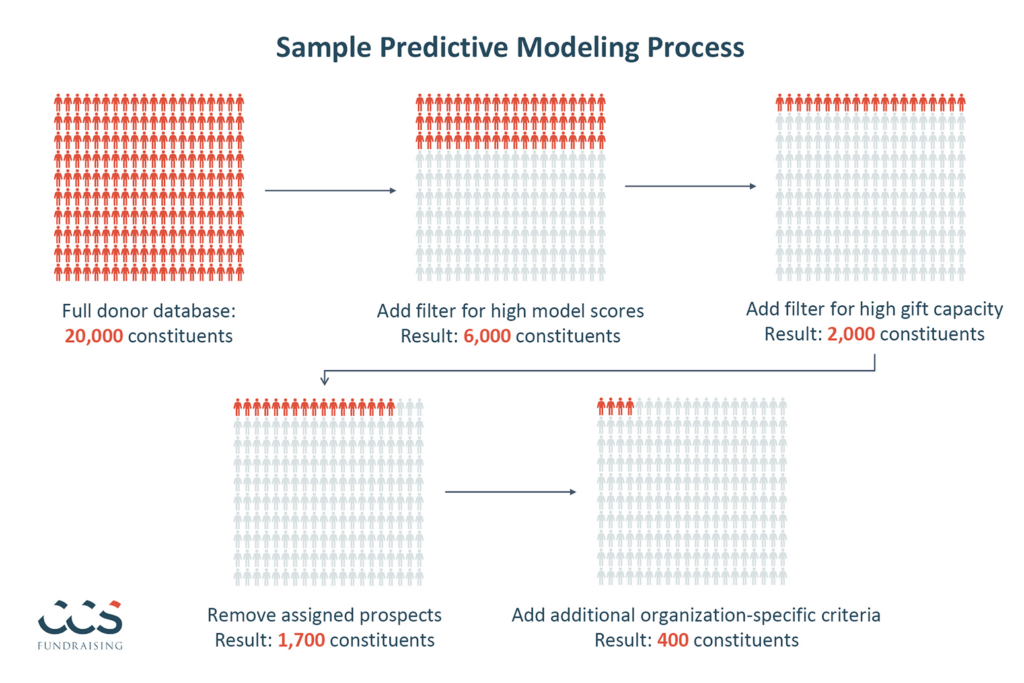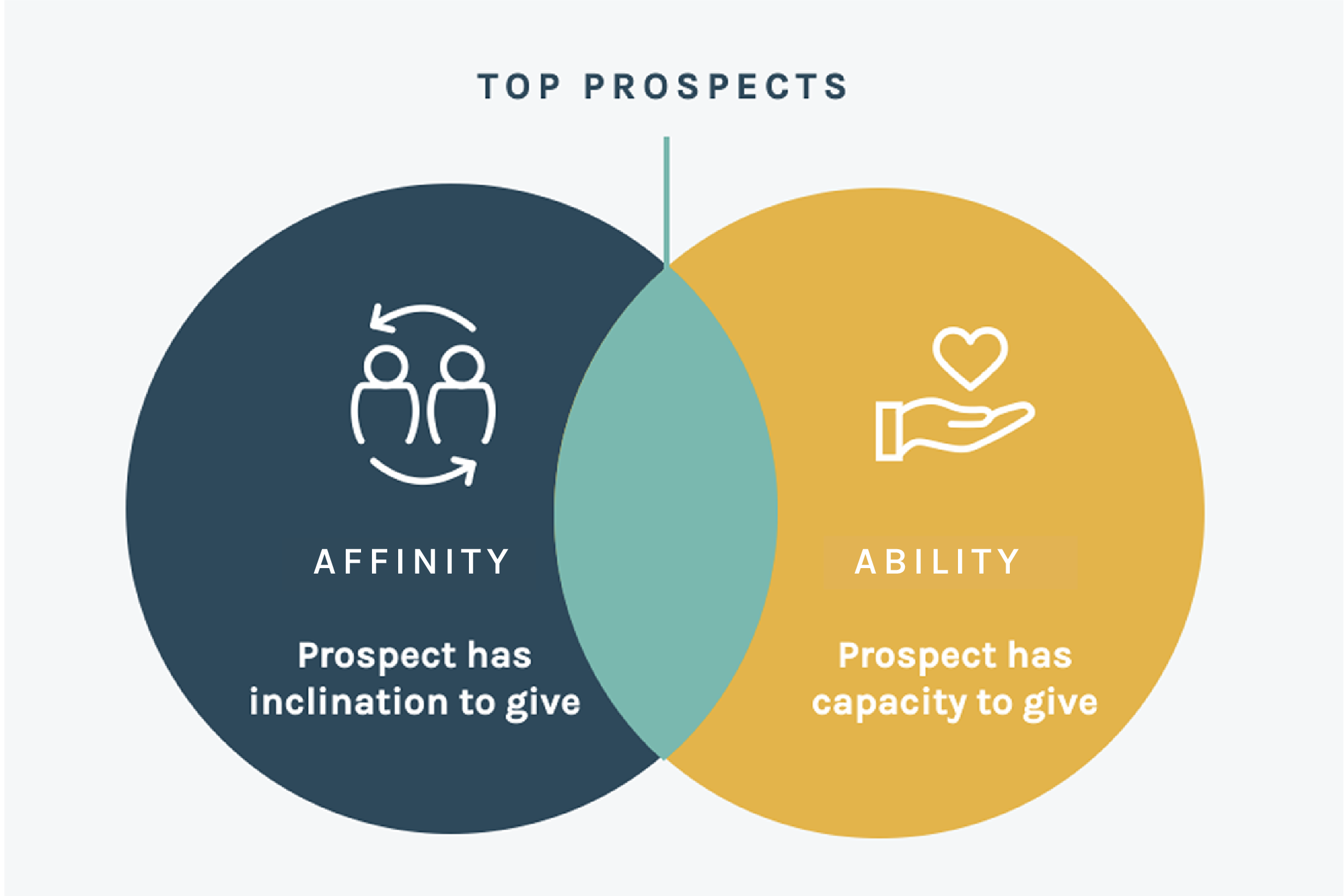Do you believe your donor database could reveal untapped major gift prospects but find it too challenging and time-consuming to dive further into major donor fundraising?
Fortunately, advances in technology and data analytics have created ways to streamline and maximize your efforts. Specifically, predictive AI and statistical modeling offer powerful tools to help nonprofits leverage their resources more effectively and achieve fundraising success. Just as for-profit businesses often use predictive analytics to grow revenue, nonprofit organizations can use it to improve fundraising results. At CCS Fundraising, we use predictive AI with our nonprofit client partners to identify new or unmanaged major gift prospects efficiently, methodically, and accurately.
What Is Predictive AI?
Predictive Artificial Intelligence (AI) uses statistical algorithms and machine learning techniques to analyze data and predict future outcomes. In major gifts fundraising, predictive AI can reveal the donors most likely to make a large gift based on their past giving behavior, demographic characteristics, wealth indicators, and other relevant factors.
How We Use Predictive AI to supercharge major donor fundraising
CCS has developed a multi-step process to assess donor potential in your database that, once completed, gives you a list of the most promising new major gift prospects.

Step 1: we use predictive statistical modeling
In essence, a predictive model describes your promising donors in statistical terms. The process starts by building a suite of predictive models predicting future donor behavior based on past tendencies, interests, and demographics. Using this information, the model finds constituents who look like those high-potential donors but aren’t yet. This statistical characterization is a formula to give each constituent in the database a numerical score, rating the prospect’s quality.
At CCS, the predictive models we develop for nonprofits incorporate diverse data elements from the donor database, encompassing contact details, donation records, event participation, volunteer engagement, and organization-specific data fields.
step 2: we wealth screen your top model scorers
The predictive model scores tell us which donors have an affinity for your nonprofit. Constituents who scored well are interested in your organization and will likely give you a gift. But it won’t tell us their financial ability to make a large donation.

For this reason, the next step is wealth screening research on the constituents who scored well in modeling. We can estimate how much a constituent might donate by using external wealth screening vendors and then combine the wealth screening and modeling scores to isolate ideal major gift prospects between affinity and ability.
Step 3: we Remove the Assigned Constituents and Those Above a Certain Age
The process aims to identify new major gift prospects, so we remove constituents already assigned to a major gift officer’s portfolio. We also filter for age to ensure a solid list of prospects in a life stage where it makes sense to be cultivated for a major gift.
Step 4: we Use Model Scores, Wealth Screening Data, and Recent Giving to Generate the Final List
We have found that concise lists of compelling new major gift prospects are most beneficial for development teams. We create a more manageable list for your organization by adding extra filters towards the end of our process—like fine-tuning model score thresholds, gift potential, and recent donations.
What is the value of using predictive aI to find new major gift prospects?
CCS has seen a tremendous return on investment in predictive AI for our clients.
In a study of past clients who utilized CCS’s predictive AI services, the median organization’s “Top Prioritized Prospects”—those high-potential donors not yet assigned to a gift officer but recommended by CCS to be included—donated seven times more compared to all other donors.
How else can predictive AI be used in Major Donor fundraising and Beyond?
Predictive AI and statistical modeling can support development strategies and objectives such as:
- Convert crisis donors to long-term donors.
- Strategize engagement and outreach for planned giving prospects.
- Develop acquisition, retention, and segmentation strategies for annual giving.
- Build a pipeline of young alums most likely to be future major donors.
- Prioritize grateful patient outreach.
- Optimize major gift officer portfolios by adding new prospects and identifying prospects to remove from portfolios.
Leverage the Power of Predictive AI for Major Donor Fundraising
CCS has an expert Data Analytics team dedicated to helping nonprofits worldwide harness innovative techniques like statistical modeling and machine learning for more successful fundraising, including major donor fundraising. Our in-house data scientists use various analytical tools to develop customized, creative, and actionable fundraising strategies unique to each client’s needs. Discover our Services for more details on our Data Analytics offerings, or contact us today .
More Insights
How to Strengthen Your Donor Portfolio With Data Analytics
Learn how to effectively analyze, refine, and refresh your donor portfolio to secure long-term fundraising success.
How to Analyze CRM Data: The Hidden Power of Your Database
Unlock the potential of your organization’s CRM and data management techniques to secure long-term fundraising success.